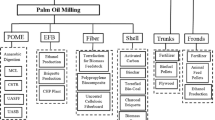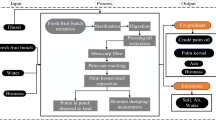Abstract
Background, aim, and scope
Globally, 45 million metric tonnes of palm oil has been produced in 2009. The production of 1 t crude palm oil requires 5 t of fresh fruit bunches (FFB). On average, processing of 1 t FFB in palm oil mills generates 230 kg empty fruit bunches (EFB) and 650 kg palm oil mill effluent (POME) as residues. These residues cause considerable environmental burdens, particularly greenhouse gas emissions. In order to reduce those emissions, four waste management options are compared in the present study using 1,000 kg of FFB as functional unit.
Methods
A detailed life cycle model has been used to calculate the environmental impacts of POME and EFB treatment. The options under investigation are: (1) dumping EFB and storing POME and ponds, (2) returning EFB to the plantation and POME as before, (3) using EFB and POME for co-composting and returning the produced compost to the plantation, (4) generating biogas from POME and thereafter as in (3). The CML 2001 method included in the GABI 4.3 software package has been used for the impact calculations. Sensitivity analysis has been carried out in order to estimate the influence of good and poor management practice on the environmental performance.
Results and discussion
The main contributor to the GWP is methane from POME and EFB dumping. The GWP of palm oil mill waste treatment can be reduced from 245 kg CO2eq per ton FFB to up to 5 kg CO2eq per ton FFB due to reduced methane emissions and nutrient recycling. Co-composting of POME and EFB leads to considerable nutrient recovery, in addition to GWP reduction. Thus, the composting process reduces not only environmental burdens; it also leads to net environmental benefit regarding most environmental impact categories, e.g., acidification potential, eutrophication potential, ozone layer depletion potential, etc. due to the avoided emissions from inorganic fertilizer production. The recovery of nutrients in EFB can be achieved by solely returning it to the plantation, but only the combined treatment of EFB and POME allows nutrient recovery from POME while methane emissions from pond systems are avoided simultaneously. The fermentation of POME to produce biogas reduces environmental burdens when operating under best practice conditions. However, fugitive biogas emissions of more than 2% reverse that beneficial effect.
Conclusion and recommendation
A life-cycle-based comparison of conventional and advanced treatment systems for EFB and POME can support decision makers regarding waste treatment options and provide information on technology risks involved. The results of this study may be used as basic calculation data for clean development mechanism for palm oil mills. LCA is shown to be a powerful tool to estimate and compare environmental impacts of different options. Unfortunately, it is rarely used in the palm oil industry in order to improve or optimize palm oil production systems. This study has shown that nutrient recovery from POME and EFB offers considerable environmental and economic benefits to palm oil production systems. However, using EFB for energy production, as it is discussed and realized by some palm oil mills, prohibits environmental beneficial POME utilization. Best waste management practice reduces emissions at palm oil mills and consequently the carbon footprint of palm oil products. Co-composting of EFB and POME, with or without prefermentation of POME in a biogas plant, is a profitable way to use the nutrients from both POME and EFB.



Similar content being viewed by others
References
Arrieta FRP, Teixeira FN, Yanez E, Lora E, Castillo E (2007) Cogeneration potential in the Columbian palm oil industry: three case studies. Biomass Bioenergy 31(7):503–511
Chan KW (2005) Best-developed practices and sustainable development of the oil palm industry. Journal of Oil Palm Research 17:124–135
Chee KH, Chiu SB (1999) Fruit waste recycling by mulching with empty fruit bunches. The Planter 75(882):435–442
Chew TL, Bhatia S (2008) Catalytic processes towards the production of biofuels in a palm oil and oil palm biomass-based biorefinery. Bioresour Technol 99:7911–7922
Corley RHV (2009) How much palm oil do we need? Environ Sci Policy 12:134–139
PE Europe (2003) Software and database for life cycle engineering. PE Europe GmbH and IKP University of Stuttgart, 2003
FNR (2009) Biogas-Messprogramm II. 61 Biogasanlagen im Vergleich. ISBN 978-3-9803927-8-5, 168 pp
Goh KJ, Chew PS, Kee KK (1994) Nutrient for mature oil palm in Malaysia. IPI Research Topics no. 17, 36 pp
Guinée JB (ed) (2002) Handbook on life cycle assessment: operational guide to the ISO standards. Kluwer Academic, Dordrecht, 1-4020-0228-9
Gurmit S, Manoharan S, Toh TS (1990) United plantations approach to palm oil mill by-product management and utilisation. In: Proceedings of the 1989 POROM International Palm Oil Development Conference—Agriculture. Palm Oil Research Institute of Malaysia, Kuala Lumpur, pp 225–234
Hansen S (2007) Feasibility study of performing a life cycle assessment on crude palm oil production in Malaysia. Int J Life Cycle Assess 12(1):50–58, 9 pp
Husain Z, Zainal ZA, Abdullah MZ (2003) Analysis of biomass-residue-based cogeneration system in palm oil mills. Biomass Bioenergy 24(2):117–124
ICTSD (2008) Biofuel production, trade and sustainable development. International Centre for Trade and Sustainable Development, Geneva
IPCC (2006a) Guidelines for national greenhouse gas inventories, vol. 5. Solid waste disposal, Chapter 3.2.3. http://www.ipcc-nggip.iges.or.jp/public/2006gl/pdf/5_Volume5/V5_3_Ch3_SWDS.pdf. Accessed January 26, 2010
IPCC (2006b) Guidelines for national greenhouse gas inventories, vol. 5. WASTE, Chapter 4, http://www.ipcc-nggip.iges.or.jp/public/2006gl/pdf/5_Volume5/V5_4_Ch4_Bio_Treat.pdf. Accessed January 26, 2010
IPCC (2007) Climate change 2007: synthesis report. In: Core Writing Team, Pachauri RK, Reisinger A (eds) Contribution of Working Groups I, II and III to the Fourth Assessment Report of the Intergovernmental Panel on Climate Change. IPCC, Geneva, Switzerland, 104 pp
ISO (2006a) ISO 14040: environmental management—life cycle assessment—principles and framework. ISO, Geneva
ISO (2006b) ISO 14044: environmental management—life cycle assessment—requirements and guidelines. ISO, Geneva
Joelianingsih MH, Hagiwara S, Nabetani H, Sagara Y, Soerawidjaya TH, Tambunan AH, Abdullah K (2008) Biodiesel fuels from palm oil via the non-catalytic transesterification in a bubble column reactor at atmospheric pressure: a kinetic study. Renewable Energy 33(7):1629–1636
PEACE (2007) Indonesia and climate charge: current status and policies. http://siteresources.worldbank.org/INTINDONESIA/Resources/Environment/ClimateChange_Full_EN.pdf. Accessed January 26, 2010
Reijnders L, Huijbregts MAJ (2008) Palm oil and the emission of carbon-based greenhouse gases. J Cleaner Prod 16(4):477–482
Rettenmaier N, Reinhardt G, Münch J, Gärtner S (2007) Netzwerk Lebenszyklusanalysen Datenprojekt “Nachwachsende Rohstoffe”. ifeu-Institut für Energie-und Umweltforschung Heidelberg GmbH, pp 1–42
Schmidt JH (2007) Life cycle assessment of rapeseed oil and palm oil (summary Report). Aalborg University, Department of Development and Planning
Schmidt JH, Christensen P, Christensen TS (2009) Assessing the land use implications of biodiesel use from an LCA perspective. J Land Use Sci 4:35–52
Schuchardt F, Susilawati E, Guritno P (1998) Influence of C/N ratio and inoculum upon rotting characteristics of oil palm empty fruit bunch. In: Proceedings of 1998 International Palm Oil Conference Chemistry, Bali, Indonesia, September 23–25, 1998, pp 501–510
Schuchardt F, Wulfert K, Damoko D, Darmosarkoro W, Sutara ES (2001) Feasibility study on full-scale plants for treatment of waste water and solid waste from palm oil mills. pp 1–142
Schuchardt F, Wulfert K, Darnoko D (2002a) A new, integrated concept for combined waste (EFB) and waste water (POME) treatment in palm oil mills—technical, economical and ecological aspects. Enhancing oil palm industry development through environmentally friendly technology. In: Proceedings of Chemistry and Technology Conference, Nusa Dua Bali, Indonesia, July 8–12, 2002, pp 330–343
Schuchardt F, Darnoko D, Guritno P (2002b) Composting of empty oil palm fruit bunch (EFB) with simultaneous evaporation of oil mill waste water (POME). Enhancing oil palm industry development through environmentally friendly technology. In: Proceedings of Chemistry and Technology Conference, Nusa Dua Bali, Indonesia, July 8–12, 2002, pp 235–243
Schuchardt F, Wulfert K, Darnoko D, Herawan T (2006) Sustainable waste water (POME) and waste (EFB) management in palm oil mills by a new process. In: Proceedings of the International Oil Palm Conference 2006, Chemistry Technology Economics, Nusa Dua, Bali, Indonesia, 19–23 June, 2006, pp 201–211
Schuchardt F, Wulfert K, Darnoko D, Herawan T (2008) Effect of new palm oil mill processes on the EFB and POME utilisation. Journal of Oil Palm Research (Special Issue October 2008):115–126
Shuit SH, Tan KT, Lee KT, Kamaruddin AH (2009) Oil palm biomass as a sustainable energy source: a Malaysian case study. Energy 34(9):1225–1235
Subramaniam V, Ngan MA, Choo YM, Sulaiman NMN (2008) Environmental performance of the milling process of Malaysian palm oil using the life cycle assessment approach. Am J Environ Sci 4(4):310–315
Sumathi S, Chai SP, Mohamed AR (2008) Utilization of oil palm as a source of renewable energy in Malaysia. Renewable Sustainable Energy Rev 12(9):2404–2421
Sunitha S, Varghese PT (1999) Composting of oil palm wastes for efficient recycling of nutrients in palm plantations. The Planter 75(885):677–681
Tamunaidu P, Bhatia S (2007) Catalytic cracking of palm oil for the production of biofuels: optimization studies. Bioresour Technol 98(18):3593–3601
Tan KT, Lee KT, Mohamed AR, Bhatia S (2009) Palm oil: addressing issues and towards sustainable development. Renewable Sustainable Energy Rev 13(2):420–427
USDA (2009) Indonesia: palm oil production growth to continue. http://www.pecad.fas.usda.gov/highlights/2009/03/Indonesia/. Accessed January 26, 2010
USDA (2010) Palm oil: world supply and distribution. http://www.fas.usda.gov/psdonline/psdreport.aspx?hidReportRetrievalName=BVS&hidReportRetrievalID=710&hidReportRetrievalTemplateID=8. Accessed January 26, 2010
Wicke B, Dornburg V, Junginger M, Faaij A (2008) Different palm oil production systems for energy purposes and their greenhouse gas implications. Biomass Bioenergy 32(12):1322–1337
Wulfert K, Darnoko D, Tobing PL, Yulisari R, Guritno P (2002) Treatment of POME in anaerobic fixed bed digesters. Proceeding of International Oil Palm Conference IOPC 2002:265–275
Yusoff S, Hansen SB (2007) Feasibility study of performing an life cycle assessment on crude palm oil production in Malaysia. Int J Life Cycle Assess 12(1):50–58
Acknowledgement
The authors acknowledge Dr. Tjahono Herawan (Indonesian Oil Palm Research Institute, IOPRI, Medan, Indonesia) and Dipl.-Ing. Klaus Wulfert (UTEC, Bremen, Germany) for valuable data and discussion.
Author information
Authors and Affiliations
Corresponding author
Additional information
Responsible editor: Shabbir Gheewala
Rights and permissions
About this article
Cite this article
Stichnothe, H., Schuchardt, F. Comparison of different treatment options for palm oil production waste on a life cycle basis. Int J Life Cycle Assess 15, 907–915 (2010). https://doi.org/10.1007/s11367-010-0223-0
Received:
Accepted:
Published:
Issue Date:
DOI: https://doi.org/10.1007/s11367-010-0223-0




